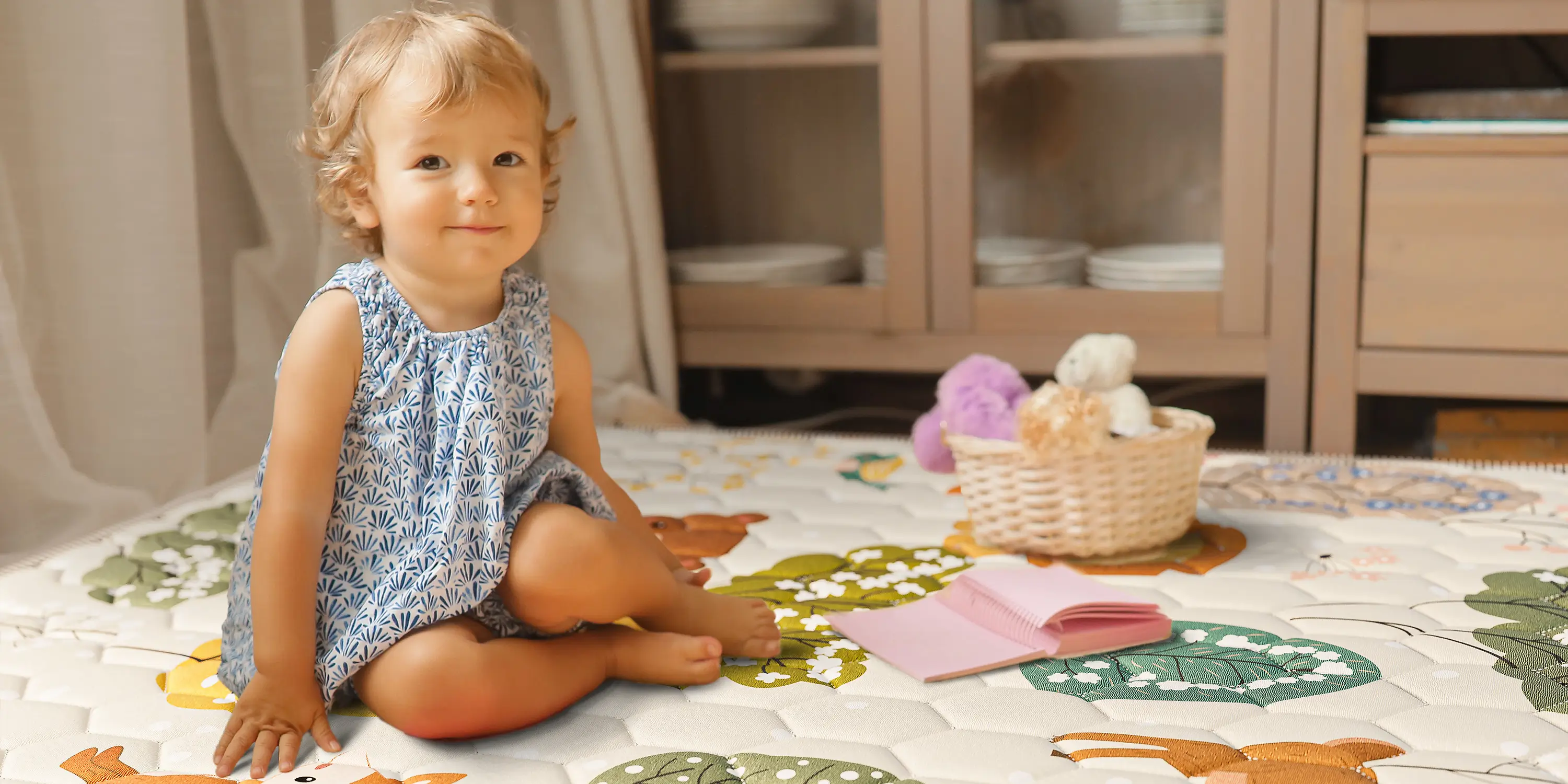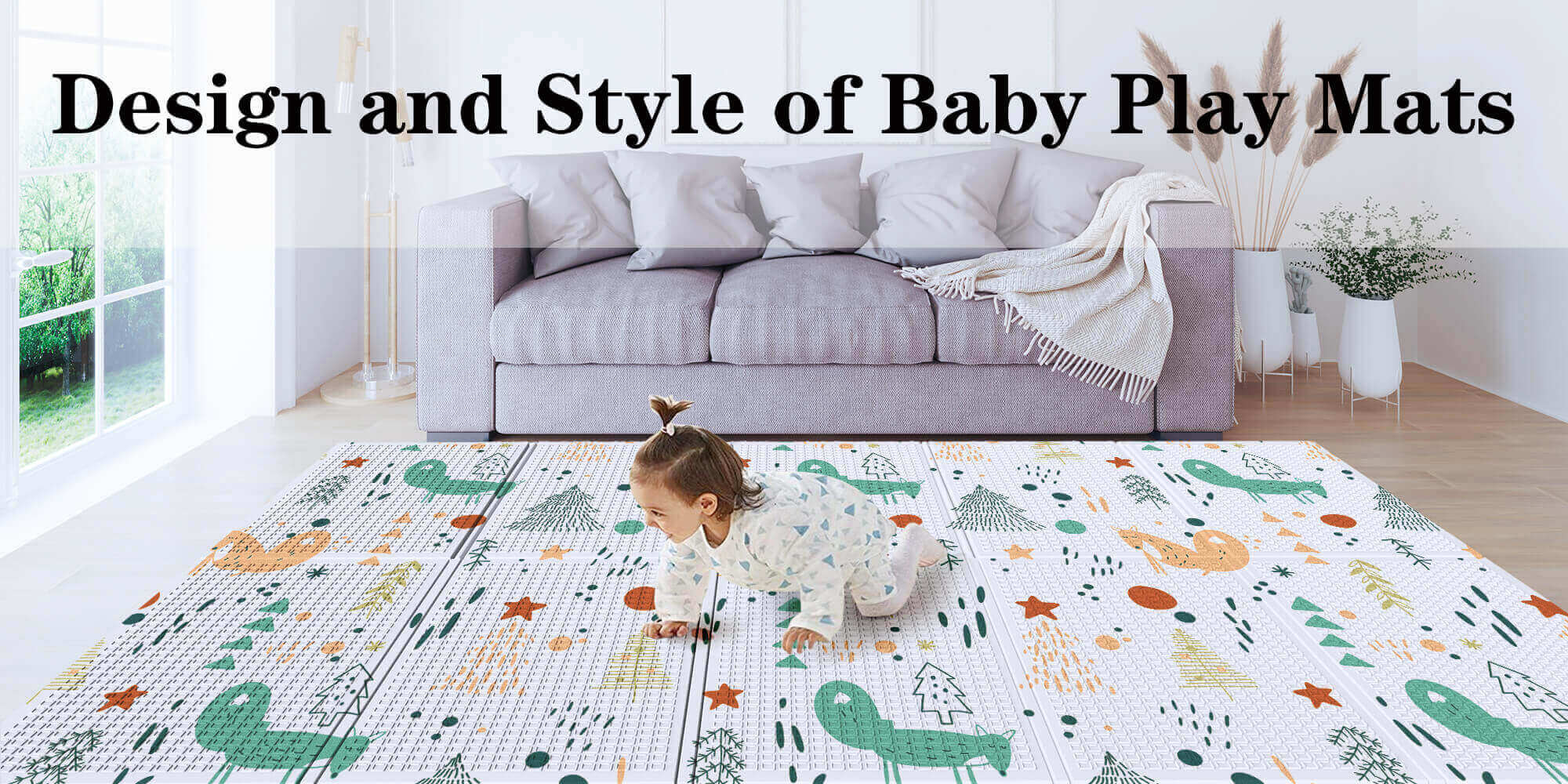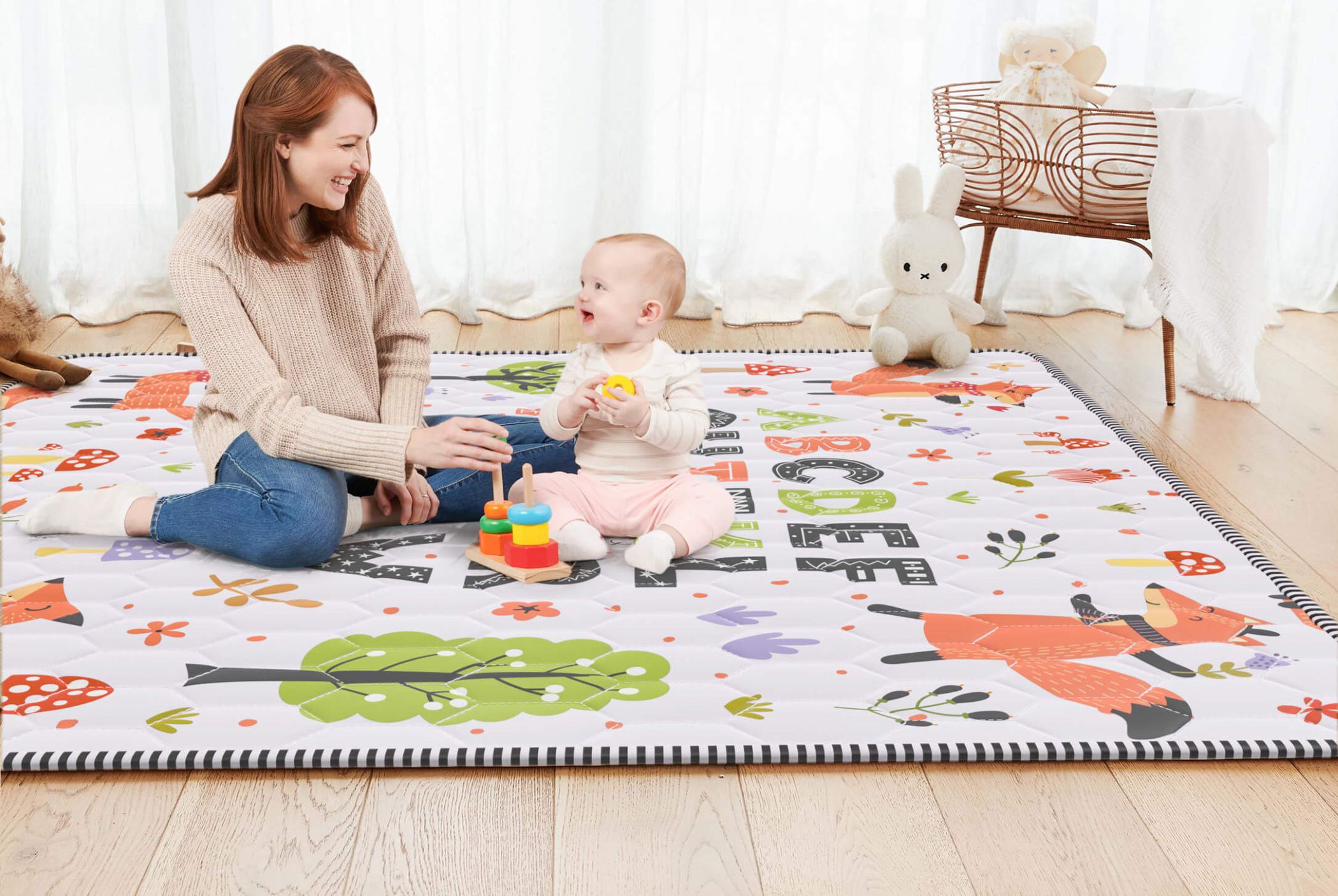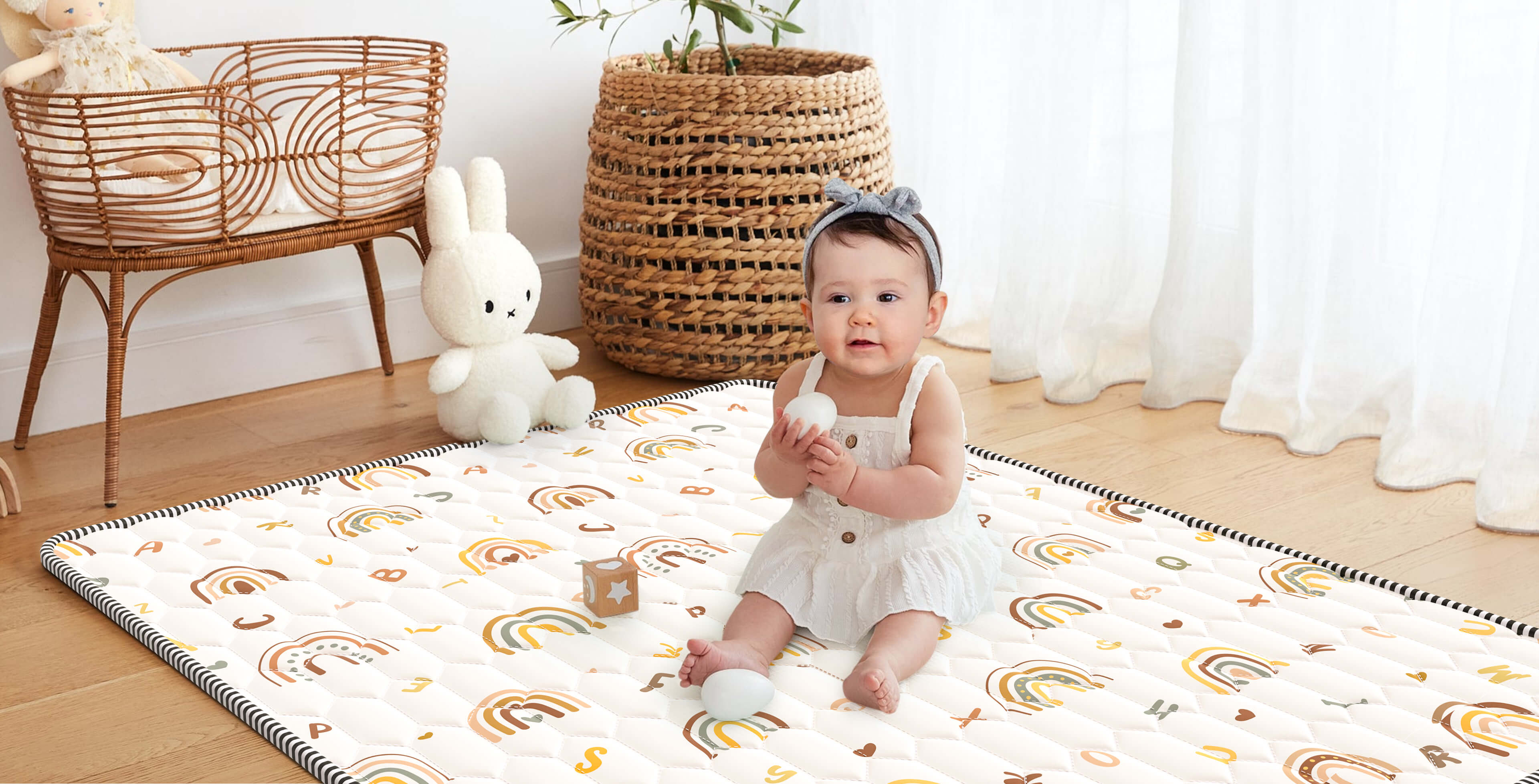
- Home
- Baby Product Guides
- Baby Play Mats: A Comprehensive Guide for Parents
Baby Play Mats: A Comprehensive Guide for Parents
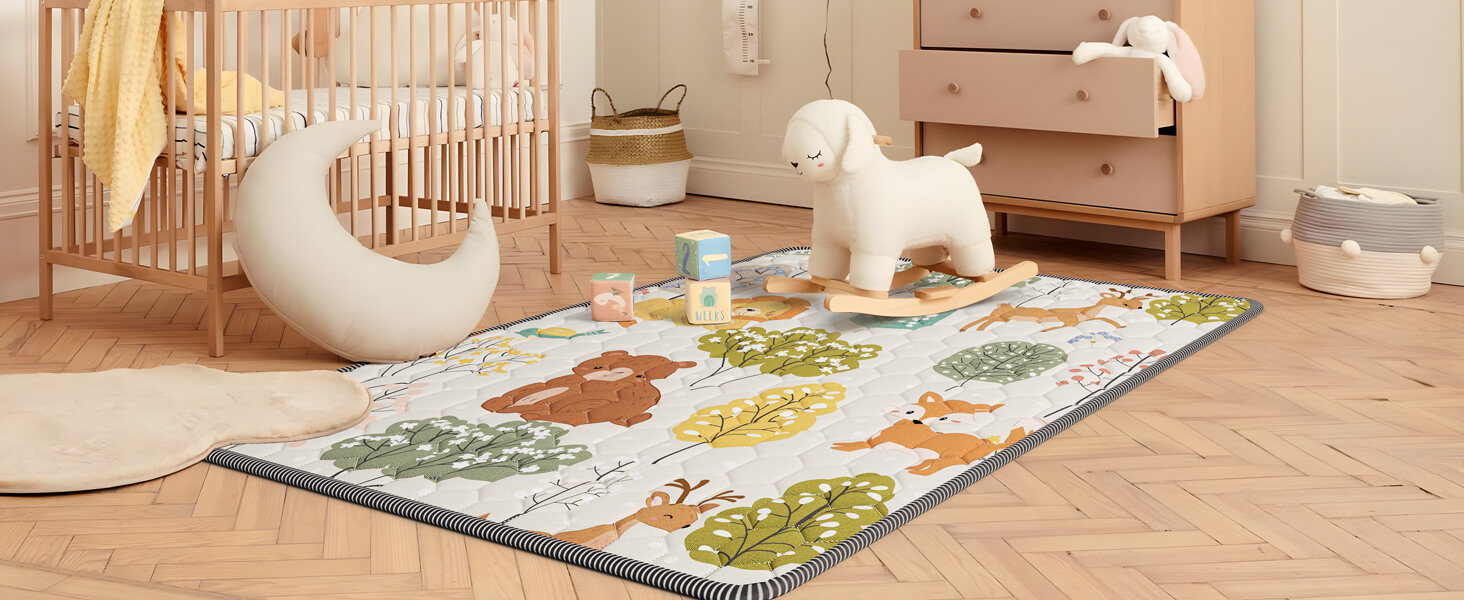
When it comes to creating a safe and enjoyable play environment for your baby, the importance of a high-quality play mat cannot be overstated. Baby play mats serve as a foundational piece of your child’s daily activities, offering not only a soft surface but also a stimulating environment that fosters motor skill development, cognitive growth, and physical safety. This article explores the intricacies of baby play mats, focusing on the materials, features, and considerations every parent should keep in mind. We will also spotlight some of the best products on the market, including ieBabay’s play mats, which are known for their softness, durability, and safety.
1. What Is a Baby Play Mat?
A baby play mat is a padded surface designed to create a safe, comfortable space for infants to play, crawl, and explore. It provides a cushioned area that protects babies from hard floors, reducing the risk of injury during tummy time or when learning to sit, crawl, or walk. Often made from non-toxic, hypoallergenic materials, play mats feature vibrant colors, textures, and interactive elements to stimulate sensory development. They serve as an essential tool in aiding fine motor skills, cognitive growth, and overall physical development during a child’s early stages.
2. Why Every Parent Needs a Baby Play Mat

A baby play mat is an essential item for any parent, offering a variety of benefits that support a child’s development while ensuring safety and comfort. Here’s why every parent should consider investing in one:
Safe Play Area: A play mat provides a soft, cushioned surface where babies can explore and play without the risk of injury on hard floors. This creates a secure environment for rolling, crawling, and sitting up.
Encourages Motor Skills: Play mats are designed to promote gross motor development by encouraging babies to move, reach, and stretch. This helps strengthen muscles needed for crawling, sitting, and standing later on.
Stimulates Sensory Development: Many mats include various textures, colors, and patterns that engage babies’ senses. Features like crinkly fabrics or attached toys help stimulate tactile, visual, and auditory senses, supporting overall sensory growth.
Cognitive Growth: Play mats often include interactive elements that help develop cognitive skills, including problem-solving and object recognition. Engaging with toys on the mat encourages hand-eye coordination and boosts brain development.
Portable and Easy to Clean: Most play mats are lightweight and foldable, making them easy to carry from room to room or even outdoors. Many are also waterproof or machine washable, simplifying maintenance for busy parents.
3. Materials and Safety Considerations
When selecting a baby play mat, the material is one of the most critical factors. Parents should look for mats made from non-toxic, hypoallergenic, and BPA-free materials to ensure their baby’s safety. Here’s a breakdown of common materials used in baby play mats:
Foam: Foam mats are popular for their thick, cushioned surfaces that provide excellent shock absorption, protecting babies during play. It’s essential to select foam mats that are free from harmful chemicals like lead, BPA, phthalates, and formaldehyde. This ensures that the mat is both safe and long-lasting.
Cotton: Known for being soft and breathable, cotton is a natural material commonly used in play mats. It’s gentle on a baby’s skin and provides good breathability, making it suitable for long periods of use. Cotton is often blended with other materials to increase durability and enhance the texture.
Polyester: Polyester is widely used in baby play mats due to its resistance to stains and overall durability. However, it can sometimes lack breathability, so many manufacturers blend polyester with other materials to improve comfort. Polyester mats are also easy to clean and maintain, which is important for busy parents.
ieBabay Baby Play Mat: This mat exemplifies the combination of comfort, safety, and durability. This mat is made from soft microfiber with a thickened finish, offering extra cushioning for your baby’s comfort. Its surface is composed of cotton, ensuring a gentle touch on your baby’s sensitive skin, while the underlying structure is made of polyester, adding durability and resistance to wear and tear. The microfiber surface also enhances softness, making it an excellent choice for parents who want both comfort and longevity in a play mat.
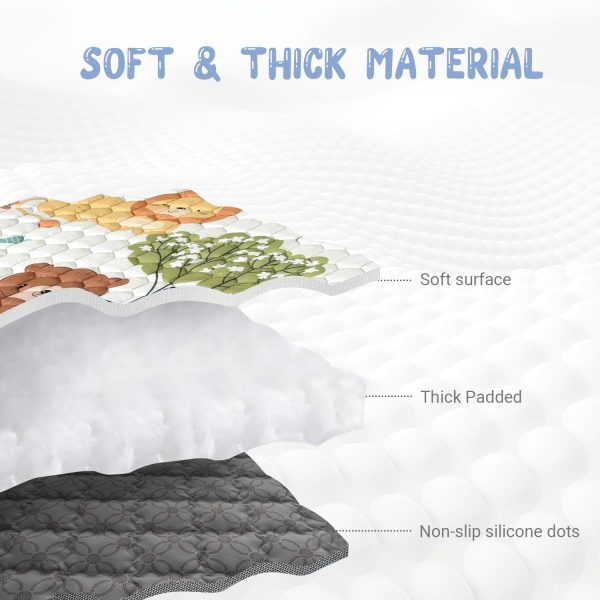
4. Key Features of a High-Quality Baby Play Mat
When choosing a baby play mat, it’s essential to focus on key features that ensure safety, comfort, and developmental benefits. Here are the top factors to consider:
Non-Toxic Materials: A high-quality baby play mat should be made from non-toxic, BPA-free, and hypoallergenic materials. These mats ensure the baby isn’t exposed to harmful chemicals like lead or phthalates.
Thick Cushioning: A good play mat should offer ample cushioning to protect your baby during tummy time, crawling, or early walking attempts. The thickness also helps reduce the risk of injury on hard floors.
Easy to Clean: Babies are prone to spills and accidents. Look for play mats that are either waterproof or machine washable, ensuring easy maintenance for busy parents.
Non-Slip Base: A non-slip backing is essential to keep the mat securely in place while your baby is moving around. This feature minimizes the risk of accidents, especially on smooth surfaces.
Interactive and Sensory Features: Many high-quality mats come with textured surfaces, vibrant colors, and toys attached, which help stimulate your baby’s senses and encourage developmental milestones like hand-eye coordination and muscle strengthening.
5. The Role of Play Mats in Development
Tummy Time: One of the most crucial activities for a baby’s early development is tummy time. It entails putting the sleeping infant on their stomach, which strengthens the muscles in the shoulders, back, and neck. An adequately cushioned play mat offers a secure and cozy surface that promotes longer periods of tummy time. Babies learn to raise their heads during tummy time, which improves head and neck control—a crucial developmental milestone. By making sure infants are comfortable while practicing these early motions, a cushioned mat lowers the possibility of pain or injury.
Cognitive Development: Play mats are designed with various interactive elements such as mirrors, squeaky toys, crinkly fabrics, and bright colors that stimulate your baby’s senses. These features encourage sensory exploration, which is essential for cognitive development. Babies start to understand cause and effect—pressing a toy makes a sound, or a mirror shows their reflection. Such sensory play enhances visual and auditory skills while encouraging curiosity and learning.
Motor Skills: The development of fine and gross motor skills is greatly aided by a play mat. Babies can safely practice reaching, rolling, and crawling on the soft, textured surface. These skills are essential for enhancing balance, coordination, and muscular development. These motions serve in laying the groundwork for more difficult motor tasks like walking and standing.
6. Top Baby Play Mats in 2024
Here’s a roundup of the top baby play mats you should consider:
ieBabay Baby Play Mat
Made from soft microfiber with a thickened finish for extra cushioning and comfort, the ieBabay play mat is perfect for parents looking for a plush, non-toxic option. Its soft cotton surface is gentle on your baby’s skin, while the polyester base ensures durability. It’s machine washable and features a slip-resistant design to ensure safety.
Meiqicool EVA Foam Puzzle Play Mat for Baby
This interlocking puzzle mat is made from EVA foam and is ideal for parents who want a customizable play space. Each tile is easy to assemble and rearrange, and the mat is free from harmful chemicals.
Tamiply EVA Soft Interlocking Floor Mats
Designed for ultimate flexibility, the Tamiply EVA mat is durable, water-resistant, and easy to clean. Its soft, cushioned surface provides optimal comfort for crawling babies.
MioTetto Soft Non-Toxic Baby Play Mat
This stylish mat is perfect for modern homes, offering soft cushioning with a contemporary design. The MioTetto mat is non-toxic and hypoallergenic, ensuring it’s safe for babies with sensitive skin.
Yay Mats Stylish Extra-Large Baby Play Mat
The Yay Mats play mat is known for its extra-large size, making it perfect for babies who love to roam. With a foam surface that is free from toxic chemicals, it provides a safe and stylish space for playtime.
7. How to Choose the Right Baby Play Mat
To help you decide which baby play mat is best for your needs, here are a few factors to consider:
Safety and Materials: Look for mats made from non-toxic, BPA-free, and hypoallergenic materials to avoid harmful chemicals. Ensure it has passed safety certifications to protect your baby from exposure to toxins.
Comfort and Thickness: Opt for a thick mat that provides ample cushioning to prevent injuries during tummy time, crawling, and walking. Mats like the ieBabay baby play mat, which features extra cushioning and a soft microfiber finish, offer both comfort and support.
Size and Space: Consider the space you have at home. Larger play mats offer more room for your baby to move, while foldable or modular designs are ideal for smaller spaces or portability.
Ease of Cleaning: Babies can be messy, so choosing a mat that is easy to clean is important. Look for waterproof or machine-washable options for quick and efficient maintenance.
Design and Features: Interactive elements, like vibrant colors, textures, or built-in toys, help stimulate your baby’s senses. Some mats feature educational designs, like letters or animals, to enhance early learning.
Portability and Storage: If you need to move the mat often or take it on trips, opt for lightweight, foldable mats that can be easily transported or stored.
8. Maintaining Your Baby Play Mat
Keeping your baby’s play mat clean and well-maintained is crucial for their health. Here are some maintenance tips:
Daily Cleaning: Using a moist cloth, wipe down the surface to eliminate spills, dust, and debris. To remove persistent stains, use a gentle baby-safe cleanser.
Deep Cleaning: Some play mats, such as the ieBabay Baby Play Mat, may be machine washed. To protect the material’s integrity, always follow the manufacturer’s directions and wash on a gentle cycle with cold water.
Avoid Harsh Chemicals: To safeguard your baby from harmful substances, use non-toxic cleaning products. Regular home cleaners may contain chemicals that are irritating to a baby’s skin.
Drying and Storage: After cleaning, make sure the mat is completely dry before storing it. Roll or fold the mat neatly to avoid creases, and keep it in a cool, dry place to prevent mold and mildew formation.
Check for Wear and Tear: Inspect the mat on a regular basis for signs of damage, such as tears or thin padding. Replace the mat if it is severely worn, as damaged surfaces might compromise safety and comfort.
Conclusion
Choosing the right baby play mat is an investment in your child’s comfort, safety, and development. Whether you’re looking for a mat that offers superior cushioning, interactive features, or simply a safe space for your baby to explore, there are countless options available. The ieBabay Baby Play Mat stands out for its softness, durability, and non-toxic design, making it a top choice for parents in 2024.

